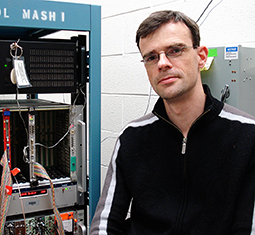Charge-Exchange experiments - High Rigidity Spectrometer - Helium-Jet Ion Guide
Charge-exchange reactions at intermediate energies have long been recognized as an important tool to study the spin-isospin response of nuclei. Besides the direct information they provide about the structure of nuclei, they have specific applications relating to other fields such as astrophysics (e.g. supernovae, processes in neutron-star crusts) and particle physics (e.g. neutrinoless double beta decay). The charge-exchange group at the NSCL has a broad program aimed at all of these aspects and closely collaborates with theorists and astrophysicists, for example to create a weak-rate library for astrophysical simulations Read More...
A variety of charge-exchange probes are available . To study the spin-isopsin response of stable nuclei, the NSCL charge-exchange group uses the (t,3He) and (3He,t) reactions, at 115 MeV/u and 140 MeV/u, respectively. The (t,3He) experiments are performed at the NSCL, using a secondary triton beam and (3He,t) experiments are done at RCNP, Osaka. Our group is pioneering charge-exchange studies on rare isotopes at the NSCL and focus on the (7Li,7Be) and (p,n) reactions in inverse kinematics. In addition, novel probes such as the (10Be,10B) and (6Li,6Li') are being investigated. Read More...

The High Rigidity Spectrometer (HRS) will be the centerpiece experimental tool of the The Facility for Rare Isotope Beams (FRIB) fast-beam program. The high magnetic rigidity of the HRS (8 Tm) will match the rigidities for which rare-isotope production yields at the FRIB fragment separator are maximum across the entire chart of nuclei and enable experiments with the most exotic, neutron-rich nuclei available at FRIB. Initial Ion-optical and Associated Magnet Feasibility Studies for a High Rigidity Spectrometer for FRIB are currently being funded through a DOE Office of Science grant (DE-SC0014554).Read more on the website of the FRIB High Rigidity Spectrometer Workinggroup...
A Helium-Jet ion-Guide System (HJ-IGS) is currently being implemented to enable a new capability for experiments with rare-isotope beams in commensal operation. The HJ-IGS is based on a design by Chalk-River Nuclear laboratories, reassembled and updated by ORNL, UNIRIB, the Center for Radioactive Ion Beams for Stewardship Science, and tested at ORNL with additional support from NSCL/FRIB. A NSF-MRI grant (PHY-1531199) enables the development and implementation of the HJ-IGS at NSCL.
Contact and Useful links
- Remco G.T. Zegers
- Professor of Physics & Associate Director for Experimental Research
- zegers at nscl.msu.edu
- NSCL, Michigan State University
- 640 S. Shaw Lane
- Room 1017
- Tel: +1-517-908-7473